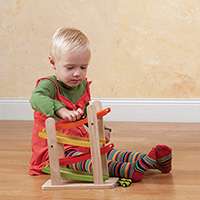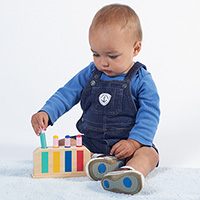
"There are many ingenious ways of 'fixing up' your child's room."
—Elizabeth Hainstock Teaching Montessori in the Home
 Once your child has learned to crawl and toddle, it's time to redesign the nursery. The baby's room was originally organized to make it easy and convenient for parents and caretakers. At this stage, it's time to adapt the environment to address your child's growth.
Once your child has learned to crawl and toddle, it's time to redesign the nursery. The baby's room was originally organized to make it easy and convenient for parents and caretakers. At this stage, it's time to adapt the environment to address your child's growth.
The nursery previously served as baby's place for sleeping, changing, nursing, and dressing. Now, it's time for some independence. By the age of 15 months, most children can walk without help, as well as comprehend and use some language. They are beginning to know what they want and are learning how to express their desires.
Some Montessori parents choose to use a floor bed for their baby from the beginning, preferring the openness and freedom from confinement. Others find this too taxing on their backs and instead choose a crib that adjusts in height. By the time your child begins to climb out of the crib, it's time to move him to a junior bed or mattress on the floor. Have your child help with the redesign. Talk about the plan first and then include him in the execution of the change.
Ideally, all the furniture will be child-size, though you may continue to have a comfortable adult chair for reading stories, and the changing table might stay for now. If there's space, a child-size chair and table could be added.
Now that your child will be spending time alone in her room, childproof it carefully and thoroughly. Start at the top of the room and work your way down. Tie up curtains that could be pulled down and do the same with the strings from the blinds or shades. Be certain wall decorations are securely attached and free of glass. Make sure all electrical cords are out of reach—perhaps behind a bookcase or table. Cover all electrical outlets. If shelves are taller than your child, secure them to the wall. Put locks and drawer stops on the bureau drawers. Since you're familiar with the space and your child, you will know what needs to be done to ensure your child's safety.
Install a low rod in the closet so that your child can reach her clothes, or use low shelves and fold all items. Baskets or containers on the floor can hold a minimal number of clothing items—one for socks, another for underwear, and one for pajamas. The bottom drawer of the bureau is also an option. Choose to put out just a few items of clothing for your child to choose from, including only those items appropriate to the season and easy to coordinate.
Though you will probably help her dress for a while, be sure your child can find what's needed by keeping her clothing in consistent, easy-to-reach places. Show her how to dress herself, one item at a time, and once that is mastered, add another. Underwear or pants are a good place to begin. A small stool or child-size chair could be available for putting on shoes and socks—but, the floor is good, too. If possible, mount a mirror at your child's height and keep a comb and brush nearby. Remember to encourage your child to put her dirty clothes in the hamper.
 Whether on the floor or low shelves, display a few toys that your toddler can choose to spend time exploring. Toys might include a board puzzle with knobbed single pieces, some favorite stuffed animals, a box or tray with small trucks and cars, a stacking toy, and a set of blocks, along with some books. It is much better to rotate toys rather than overwhelm your child by displaying everything at once.
Whether on the floor or low shelves, display a few toys that your toddler can choose to spend time exploring. Toys might include a board puzzle with knobbed single pieces, some favorite stuffed animals, a box or tray with small trucks and cars, a stacking toy, and a set of blocks, along with some books. It is much better to rotate toys rather than overwhelm your child by displaying everything at once.
Teach your children the habit of returning each toy to its place before getting another—a place for everything and everything in its place. Of course you'll help your child put everything away until the routine is learned. When you notice that an item is seldom chosen or used, replace it with a new one. Children love to repeat activities and feel secure with consistency, so don't change things too frequently and try to include your child in the switch process.
Maria Montessori stressed that children need a "prepared environment" that includes attractive art objects for them to enjoy. Try getting down at your child's level to survey the landscape. Is it attractive and interesting? Will your child be confident and independent in this room?
Dr. Montessori developed her theories early in the twentieth century, basing them on careful observations of infants and young children. Though our world has changed significantly since that time, the basic nature of the child is universal and has remained so. Young children become secure through a safe and orderly environment and a consistent routine that promotes independence as they spread their wings, first at home, and later, in the world.
—by Jane M. Jacobs, M.A., Montessori Educational Consultant at Montessori Services. She is a trained primary Montessori directress and also a Licensed Marriage and Family Therapist. She has taught children aged 2 to 7 years in Montessori schools, Headstart, and also in a preschool for children with developmental challenges. In her counseling practice, she helps individuals, couples, and families.
—Originally Published 2019